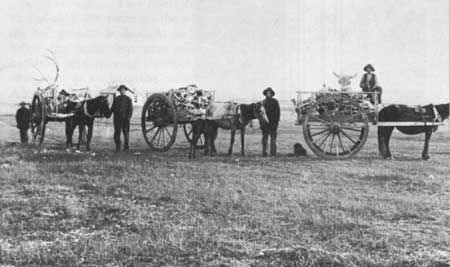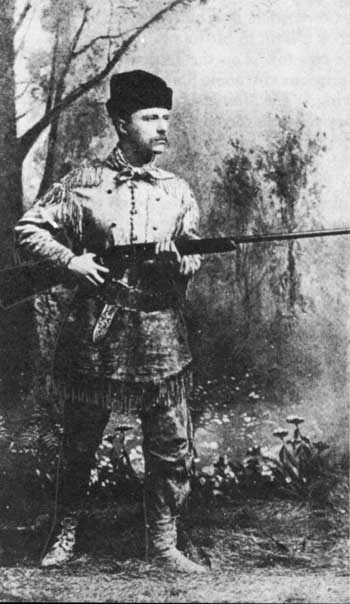|
Theodore Roosevelt and the Dakota Badlands |
 |

Bone pickers and their Red River carts.
Courtesy Haynes Studios Inc.
Roosevelt Buys a Cattle Ranch
During his buffalo hunting expedition Roosevelt had spent several evenings with Gregor Lang discussing future prospects for the cattle industry in the Badlands. One evening in the course of their conversation Roosevelt asked Lang if he would join him in a ranching venture and manage the cattle he would purchase. Being himself fully involved with Sir John Pender's cattle interests, Lang suggested Sylvane Ferris and William Merrifield who operated the Maltese Cross Ranch for Wadsworth and Hawley.
Acting upon this suggestion, Roosevelt, before returning to New York, entered into an agreement with Ferris and Merrifield and bought out the interests of Hawley and Wadsworth. According to his contract, signed at St. Paul on September 27, 1883, Roosevelt agreed to place some 400 cattle on the Chimney Butte, on Maltese Cross, Ranch at a cost of not more than $12,000. Ferris and Merrifield agreed to take care of the cattle for a 7-year period, at the end of which time 400 cattle, or their equivalent in value, were to be returned to Roosevelt and the foremen were to receive half the increase. Roosevelt was entitled by the contract to put in additional cattle on the same terms as the original 400.
Returning to New York, he was elected in November 1883, to the State Assembly, and played a part in most of the major legislation of the State for that session. However, during 1884, personal tragedy struck. Within a single night in February, both his wife and mother died. He decided that he would occupy himself by investing further in the cattle business.
In the months that followed, Roosevelt decided that if his cattle wintered well in the Badlands, he would start another ranch. Following the Republican National Convention in Chicago, which he attended as a delegate, Roosevelt took a train to Medora in June 1884.

Roosevelt in 1884. Courtesy
Houghton-Muffin Co.
On his arrival he found that the two towns on the Little Missouri had grown considerably since his previous visit some 8 months before. Medora, about a year old, was thriving. The Mandan Pioneer asserted early in 1884 that between February 1883 and the end of the year the 2 towns had grown from 4 buildings to 84. These included 3 hotels, 2 groceries, 2 general stores, a drygoods store, a newspaper office, a photography gallery, a blacksmith shop, a freight outfitting house, a laundry, a barber shop, and at least 5 saloons.
The Medora boom continued throughout 1884 and 1885. By the end of 1884 the town had 251 residents. In addition, there was a floating population estimated to number between 50 and 100 men. The Cow Boy boasted that Medora had "a larger freight, express and passenger business than any point on the Northern Pacific division, Mandan and Glendive included." (Several buildings erected during that period, including St. Mary's Catholic Church, the old Von Hoffman house, the old Joe Ferris stone, and the present Rough Rider's Hotel, have survived.) Much of Medora's prosperity, however, was due to the Marquis de Mores' packing plant and other enterprises.
In common with many of the frontier newspapers of the period, The Bad Lands Cow Boy was an outspoken champion of law and order and promoted the region in which it was located. Throughout 1884 and 1885, its owner continued to proclaim the Little Missouri as the "best cattle country in the world" and urged cattlemen to come there. He was also a strong supporter of the stockmen's organizations in eastern Montana and western Dakota.

|

|
|
Last Modified: Sat, Jan 17 2004 10:00:00 am PDT |


